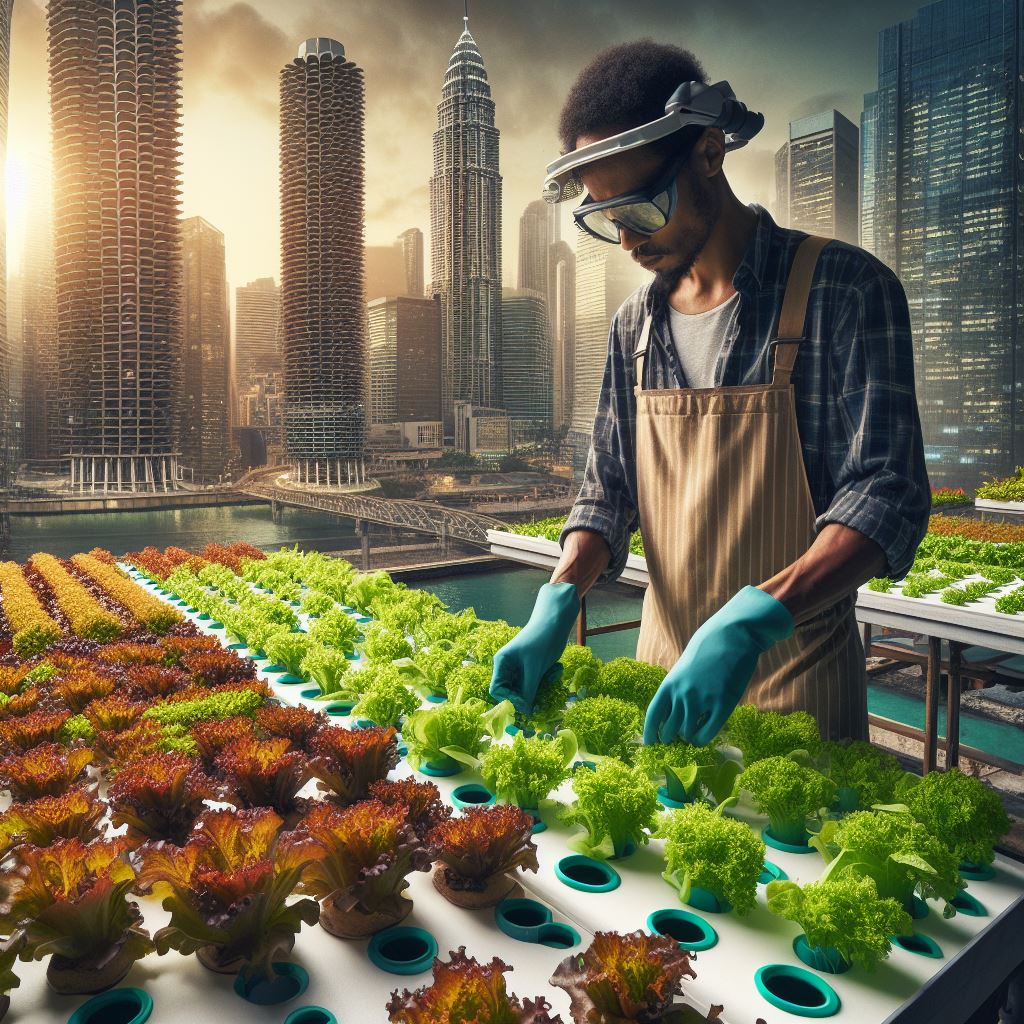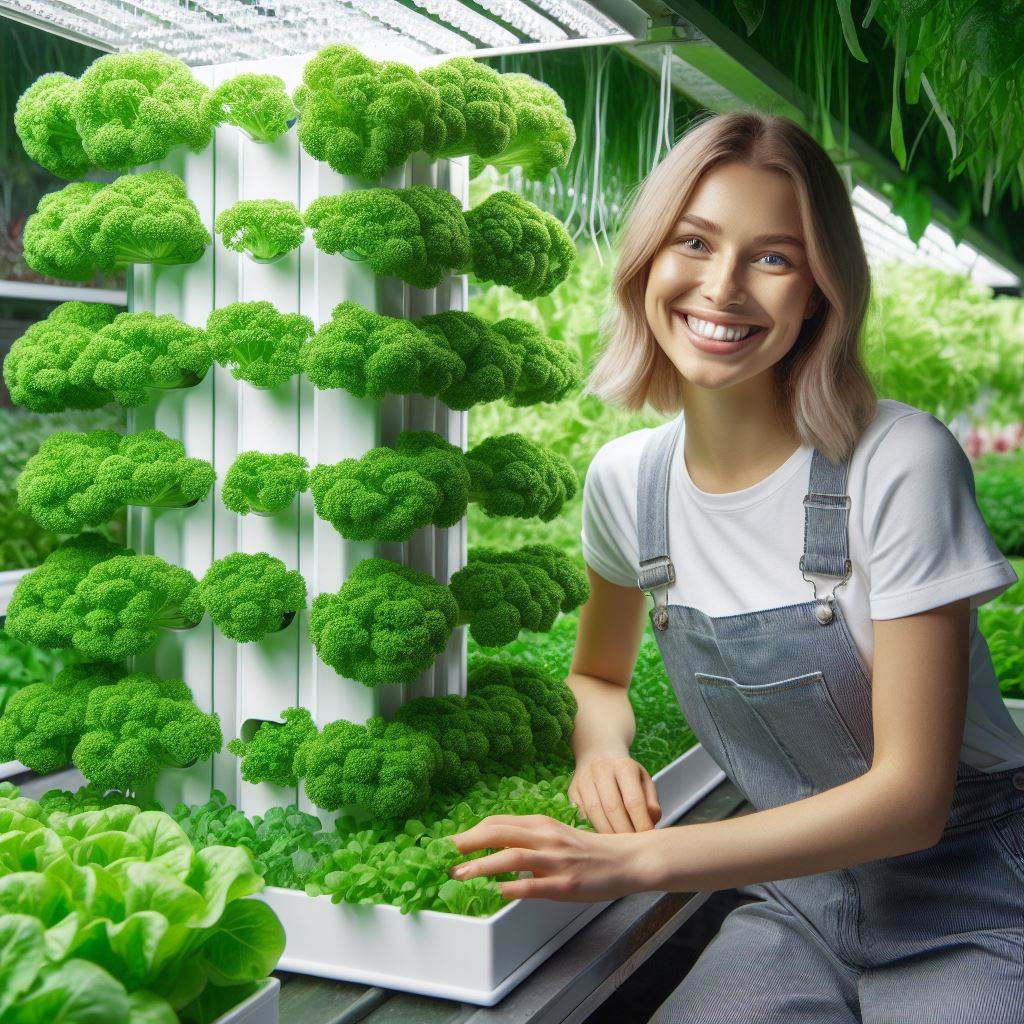Introduction
The burgeoning movement of urban farming transforms cityscapes into vibrant hubs of local food production.
By fostering the cultivation of fresh, local produce, urban farms contribute significantly to enhancing food security and sustainability within urban communities.
Aquaponics stands out as a revolutionary method within the realm of urban farming.
This closed-loop system ingeniously combines aquaculture (fish farming) with hydroponics (soilless plant cultivation), establishing a mutually beneficial relationship.
Waste produced by the fish serves as a natural nutrient source for the plants, eliminating the need for traditional soil and fertilizers.
In turn, the plants purify the water for the fish, creating a sustainable and self-sustaining ecosystem.
Delve deeper into this blog series to explore the exciting potential of aquaponics in urban environments.
We’ll unveil the possibilities for cultivating fresh, local food and contributing to a greener and more sustainable future for our cities.
Benefits of Aquaponics in Urban Farming
Urban farming using aquaponics offers numerous benefits that can revolutionize food production in cities.
By actively utilizing available space and implementing innovative techniques, aquaponics provides solutions to the challenges faced by traditional farming methods.
Efficient use of space
One key advantage of aquaponics is its efficient use of space.
Vertical farming, a method commonly used in aquaponics, allows for the utilization of vertical space.
By growing plants in vertical stacks or racks, farmers can maximize their available area and grow a large quantity of produce in a small footprint.
Rooftop areas in urban environments can be transformed into productive spaces through greenhouse cultivation, further expanding the growing area.
Conservation of water resources
Another significant benefit of aquaponics is its conservation of water resources.
Transform Your Agribusiness
Unlock your farm's potential with expert advice tailored to your needs. Get actionable steps that drive real results.
Get StartedAquaponics utilizes recirculating water systems, where water is constantly reused within the system.
This drastically reduces the amount of water required in comparison to traditional farming methods, where water is often wasted or lost through runoff.
By conserving water, aquaponics helps address the global water scarcity issue and promotes sustainable agriculture.
Year-round production
Aquaponics enables year-round production, mitigating the effects of seasonal changes on plant growth.
Unlike traditional farming, which heavily relies on weather conditions, aquaponics provides a controlled environment for plants to thrive.
This constant production ensures a steady supply of fresh produce throughout the year, even in urban areas where farming space is limited.
Enhancing food security and accessibility in cities
Aquaponics enhances food security and accessibility in cities.
The reduced transportation distance between aquaponic farms and consumers ensures that fresh produce reaches urban areas promptly and efficiently.
This reduces the reliance on long-distance transportation, which can lead to the loss of nutritional value and increased pollution.
Urban populations can access locally grown, organic produce, promoting a healthy and sustainable lifestyle.
Generally, aquaponics offers several benefits for urban farming.
Its efficient use of space through vertical farming and rooftop cultivation maximizes crop yields while conserving land.
The conservation of water resources addresses the global water scarcity issue.
Year-round production ensures a constant supply of fresh produce in urban areas.
Finally, aquaponics enhances food security and accessibility by reducing transportation distances and providing locally grown, organic food.
Incorporating aquaponics into urban farming can revolutionize food production, making cities self-sufficient and sustainable.
Read: DIY Hydroponics: Start Your Soil-less Garden!
How Aquaponics Works in Urban Settings
Aquaponics is a sustainable farming method that combines aquaculture and hydroponics in a symbiotic system.
This innovative approach to food production has gained popularity, especially in urban settings.
Let’s explore how aquaponics works in cities.
Components of an Aquaponics System
- Fish tanks: These tanks house the fish, which are an essential component of the system.
- Grow beds: These are the beds where the plants grow and receive nutrients from the fish waste.
- Plumbing and circulation system: This system ensures the water flows properly between the fish tanks and grow beds.
Symbiotic Relationship between Fish and Plants
- Fish waste providing nutrients for plants: The fish produce waste rich in ammonia, which is converted into nitrates by beneficial bacteria.
- Plants filtering the water, creating a clean environment for the fish: The plants utilize the nutrients from the fish waste, effectively filtering the water and removing harmful substances.
Integration of Technology in Urban Aquaponics
- Automated monitoring systems for water quality: Urban aquaponics often incorporates advanced sensors and monitors to ensure optimal water quality for both the fish and plants.
- Controlled environment systems for optimized plant growth: In urban settings where space is limited, aquaponic systems may utilize controlled environment technologies such as artificial lighting and climate control.
Benefits of Aquaponics
Aquaponics offers numerous benefits in urban areas.
Firstly, it allows individuals to grow fresh produce in a limited space, making it suitable for urban gardens, rooftops, and even indoor settings.
With the rise of vertical farming, aquaponics can be stacked vertically to maximize space utilization.
Urban aquaponics reduces the reliance on traditional agricultural practices that require large amounts of land and water.
Showcase Your Farming Business
Publish your professional farming services profile on our blog for a one-time fee of $200 and reach a dedicated audience of farmers and agribusiness owners.
Publish Your ProfileBy using recirculating systems, water usage in aquaponics is significantly lower compared to conventional farming methods.
The symbiotic relationship between fish and plants in an aquaponics system creates a natural and sustainable environment.
The fish supply the necessary nutrients for plant growth, while the plants filter and purify the water for the fish.
This closed-loop system minimizes waste and promotes ecological balance.
Technology plays a crucial role in the success of urban aquaponics.
Automated monitoring systems continuously monitor water quality parameters such as temperature, pH, and oxygen levels.
This ensures early detection of any imbalances, allowing for prompt adjustments and preventing potential issues.
Controlled environment systems, including artificial lighting and precise climate control, optimize plant growth and productivity.
These technologies enable year-round cultivation of various crops, eliminating the seasonal limitations typically associated with traditional farming.
Essentially, aquaponics has revolutionized urban farming by integrating aquaculture and hydroponics into a sustainable and symbiotic system.
The components of an aquaponics system, including fish tanks, grow beds, and a plumbing system, work together to create a balanced ecosystem.
The symbiotic relationship between fish and plants, along with the integration of advanced technology, allows for efficient and productive food production in urban settings.
Aquaponics represents a promising solution for addressing the challenges of urbanization and limited agricultural space.
Read: Eco-Friendly Pots: Sustainable Gardening
Challenges and Solutions in Urban Aquaponics
Limited space availability
One of the main challenges faced in urban aquaponics is the limited availability of space.
Urban dwellings are often characterized by smaller living areas, making it difficult to set up traditional aquaponic systems that require a significant amount of space.
However, there are several solutions that can be implemented to overcome this challenge.
To make the most of the limited space available in urban areas, small-scale aquaponic systems can be utilized.
These systems are designed to fit into smaller spaces while still maintaining the benefits of aquaponics.
By employing compact designs and vertical gardening techniques, such as hydroponic towers, urban farmers can maximize their production while minimizing the space required.
Managing the fish component in limited spaces
Another challenge in urban aquaponics is effectively managing the fish component within limited spaces.
The fish play a crucial role in the aquaponic system as they provide the nutrients needed for plant growth.
It can be challenging to maintain a healthy and thriving fish population in confined areas.
When it comes to selecting fish species for urban aquaponics, it is important to choose those that can thrive in smaller tanks or containers.
Some fish species are more adaptable to confined spaces and have a higher tolerance for fluctuations in water quality.
By choosing the appropriate fish species, urban farmers can ensure optimal growth and health in their systems.
In addition to species selection, maintaining optimal fish health and growth requires careful monitoring and management.
It is essential to regularly monitor water quality parameters such as temperature, pH, and ammonia levels.
Adequate filtration and aeration systems should be in place to maintain water quality and provide a healthy environment for the fish to thrive.
Risk of pests and disease in urban settings
Urban settings pose unique challenges when it comes to managing pests and diseases in aquaponic systems.
The close proximity of urban areas increases the risk of pests and diseases spreading quickly among plants and fish populations.
To mitigate these risks, urban aquaponic farmers can implement preventive measures such as integrated pest management (IPM).
IPM involves using a combination of strategies, including biological controls, cultural practices, and targeted pesticide use, to manage pest populations effectively without causing harm to the environment or beneficial organisms.
Regular monitoring of plants and fish is also essential to detect any signs of pests or diseases early.
By conducting routine inspections, farmers can identify and address issues promptly, preventing the spread of pests or diseases and minimizing any potential damage to the system.
While urban aquaponics presents its fair share of challenges, there are viable solutions available to overcome these obstacles.
Utilizing small-scale systems, employing space-saving techniques, selecting appropriate fish species, and implementing preventive measures for pests and diseases are all key strategies to ensure successful urban aquaponics operations.
Read: Pocket-Sized Herb Gardens: Urban Farming Tips

Success Stories and Examples of Urban Aquaponics
Case studies of successful urban aquaponics farms
Aquaponics has proven to be a successful and sustainable method of urban farming in numerous cities.
- Green Spirit Farms: Located in Michigan, this farm is known for its innovative aquaponics system. They produce over 10,000 heads of lettuce and 400 pounds of fish per week.
- Growing Power: Based in Milwaukee, this urban farm operates a large-scale aquaponics system. They grow a variety of vegetables and raise tilapia in their integrated set-up.
- Ouroboros Farms: Situated in California, this farm focuses on sustainable aquaponic farming. They use their system to grow a wide range of organic produce and fish.
Community engagement and education programs
Urban aquaponics not only provides food but also serves as an excellent educational tool.
Showcase Your Farming Business
Publish your professional farming services profile on our blog for a one-time fee of $200 and reach a dedicated audience of farmers and agribusiness owners.
Publish Your Profile- The Plant: Located in Chicago, this project offers aquaponics workshops and educational programs. They engage the community and promote sustainable farming practices.
- Fresh City Farms: Based in Toronto, this organization offers aquaponics classes for all ages. They aim to educate the community about sustainable food production.
- East New York Farms: Located in New York, this community farm teaches aquaponics to local residents. They empower individuals and build a stronger connection to food sources.
Positive impact on local economies and job creation
Urban aquaponics contributes to the local economy and creates employment opportunities.
- Growing Underground: Based in London, this farm utilizes abandoned tunnels for aquaponics. They have created jobs and transformed unused spaces into productive agricultural areas.
- Gotham Greens: Located in New York City, this rooftop aquaponics farm employs local residents. They provide fresh produce to the community and generate income through sales.
- Urban Organics: Situated in St. Paul, Minnesota, this farm has revitalized an old brewery into an aquaponics facility. They have created jobs in an economically disadvantaged neighborhood and improved the local economy.
In essence, urban aquaponics has shown promise and success in various cities and communities.
Through case studies of successful farms, community engagement and education programs, and positive impacts on local economies and job creation, aquaponics becomes a viable solution for urban farming.
As more examples emerge, it becomes evident that aquaponics is not only a sustainable method but also a catalyst for social and economic growth.
Read: Kitchen Window Herbs: Grow Your Own Flavor
Learn More: Herb Growing in Pots: The Compact Garden Guide
Future prospects and expansion of urban aquaponics
Potential for scalability and commercialization
- Urban aquaponics has the potential to scale up and become a viable commercial enterprise in cities.
- With advancements in technology, aquaponic systems can be optimized to maximize production and profitability.
- The demand for locally grown, sustainable food is increasing, creating a market for urban aquaponics.
- As scalability increases, costs can be reduced, making it more accessible for entrepreneurs and investors.
Integration of aquaponics into urban planning and development
- Urban aquaponics can be integrated into urban planning and development strategies to promote food security.
- By repurposing vacant lots, rooftops, and unused spaces, cities can create community gardens and aquaponic farms.
- Integrating aquaponics into urban landscapes can also enhance the aesthetics of the city, creating green spaces.
- Urban planners can collaborate with aquaponics experts to develop sustainable and efficient urban farming models.
Collaboration between government, private sector, and communities for sustainable urban farming practices
- Governments can play a crucial role in supporting and promoting urban aquaponics through policies and incentives.
- Public-private partnerships can be formed to finance and establish large-scale aquaponic farms in urban areas.
- Communities can actively participate by volunteering and supporting local aquaponic initiatives.
- Collaboration between different stakeholders can promote knowledge sharing and best practices for sustainable farming.
In a nutshell, the future prospects for urban aquaponics are promising.
Its potential for scalability and commercialization provides opportunities for entrepreneurs and investors.
By integrating aquaponics into urban planning and development, cities can promote food security and create green spaces.
Collaboration between the government, private sector, and communities is essential for the sustainable growth of urban aquaponics.
Together, we can create a more sustainable and resilient food system in our cities.
Conclusion
Aquaponics in urban farming offers numerous benefits and great potential for sustainable agriculture in cities.
Recapping the advantages, aquaponics allows for year-round cultivation, reduces water consumption by utilizing a closed-loop system, and maximizes land use efficiency.
It also provides access to fresh and nutritious produce, promotes self-sufficiency, and creates local employment opportunities.
Therefore, it is crucial for individuals and communities to explore and embrace urban aquaponics as a means to address food insecurity, enhance community resilience, and improve overall public health.
To support and promote sustainable agriculture in cities, it is necessary to take action.
This can be achieved by advocating for policies that incentivize urban aquaponics initiatives, investing in research and development, and fostering collaborations between farmers, businesses, and local government.
By supporting and promoting urban aquaponics, we can contribute to a greener and more sustainable future.
It is time to embrace the potential of aquaponics and revolutionize the way we grow food in our cities.




